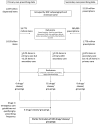The 'top 100' drugs and classes in England: an updated 'starter formulary' for trainee prescribers
- PMID: 29975799
- PMCID: PMC6177714
- DOI: 10.1111/bcp.13709
The 'top 100' drugs and classes in England: an updated 'starter formulary' for trainee prescribers
Abstract
Aims: Prescribing is a complex skill required of doctors and, increasingly, other healthcare professionals. Use of a personal formulary can help to develop this skill. In 2006-9, we developed a core list of the 100 most commonly prescribed drugs. Our aim in the present study was to update this 'starter formulary' to ensure its continued relevance for prescriber training.
Methods: We analysed large contemporary primary and secondary care datasets to identify the most frequently prescribed medicinal products. Items were classified into natural groups, broadly following their British National Formulary classification. The resulting drug groups were included in the core list if they comprised ≥0.1% prescriptions in both settings or ≥0.2-0.3% prescriptions in one setting. Drugs from emergency guidelines that did not qualify by prescribing frequency completed the list.
Results: Over 1 billion primary care items and approximately 1.8 million secondary care prescriptions were analysed. The updated list comprises 81 drug groups commonly prescribed in both settings; six from primary care; seven from secondary care; and six from emergency guidelines. Eighty-eight per cent of the formulary was unchanged. Notable changes include entry of newer anti-epileptics and dipeptidyl peptidase-4 inhibitors and exit of phenytoin and thiazolidinediones.
Conclusions: The relative stability of the core drug list over 9 years and the current update ensure that learning based on this list remains relevant to practice. Trainee prescribers may be encouraged to use this 'starter formulary' to develop a sound basis of prescribing knowledge and skills that they can subsequently apply more widely.
Keywords: general medicine; medical education; pharmacoepidemiology.
© 2018 The British Pharmacological Society.
Figures
References
-
- General Medical Council . Outcomes for graduates [online], 2015. Available at https://www.gmc-uk.org/education/undergraduate/undergrad_outcomes.asp (last accessed 23 February 2018).
-
- MSC Assessment and British Pharmacological Society . Prescribing Safety Assessment [online], 2016. Available at https://prescribingsafetyassessment.ac.uk/ (last accessed 23 February 2018).
-
- British Medical Association . The prescribing safety assessment [online], 2017. Available at https://www.bma.org.uk/advice/career/applying-for-training/prescribing-s... (last accessed 23 February 2018).
-
- World Health Organization Guide to good prescribing [online]. Available at http://whqlibdoc.who.int/hq/1994/WHO_DAP_94.11.pdf (last accessed 23 February 2018).
MeSH terms
Substances
Grants and funding
LinkOut - more resources
Full Text Sources
Other Literature Sources


